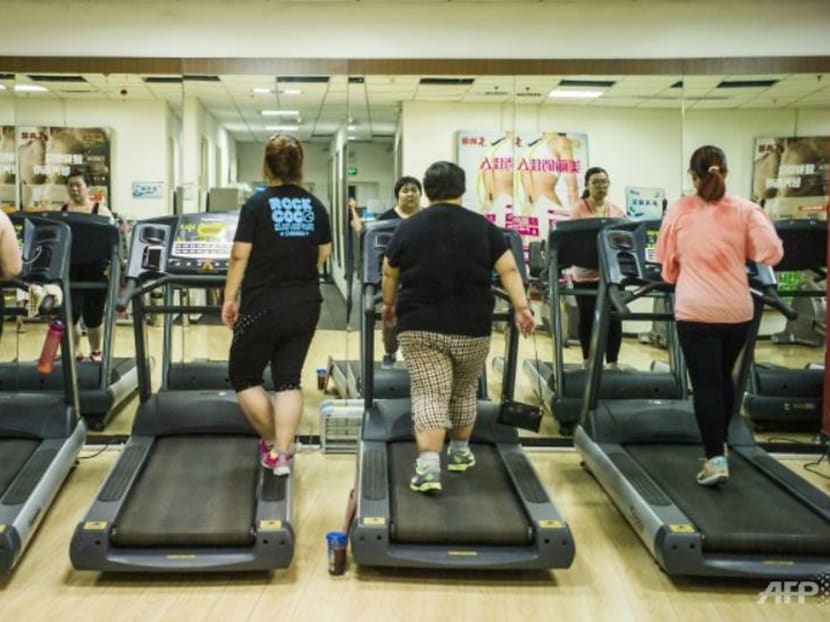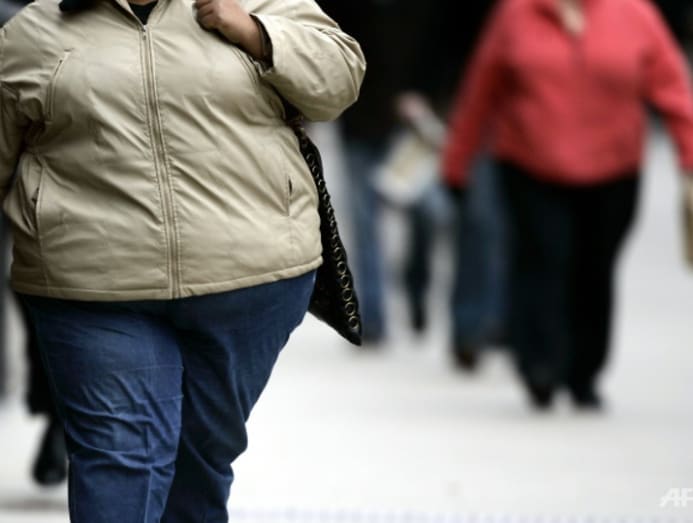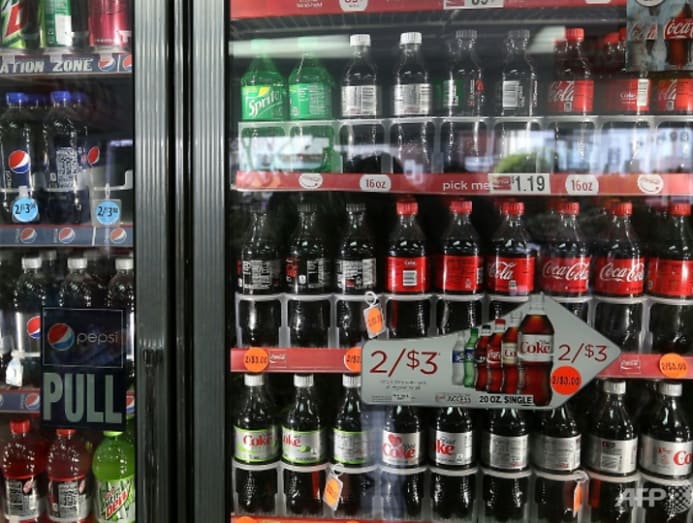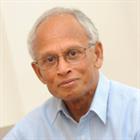commentary Wellness
Commentary: A tax on sugary drinks not enough on their own to halt obesity in Asia
Lee Kuan Yew School of Public Policy’s distinguished visiting professor Asit K Biswas and Cornell University’s Kris Hartley say to fight against obesity, a huge issue in Asia, governments must promote lifestyle changes through education and improve access to healthy foods.

(Photo: AFP/Fred Dufour)
SINGAPORE: Facing declining markets in Western countries, multinational food companies are targeting Africa, Asia and Latin America as new consumers of packaged foods, in a move that may worsen the global epidemic of chronic illness related to diabetes.
Governments are striking back at obesity risk factors, including unhealthy foods. Singapore, which might have as many as one million residents with diabetes by 2050, now requires soda producers to reduce sugar content.
Obesity and other lifestyle-related diseases have now become a “silent" long-term challenge that will cost governments in healthcare liabilities and lost productivity.
But improving public health requires more than piecemeal legislation: Governments must promote lifestyle changes through education and improve access to healthy foods.
NOT A “RICH ONLY” DISEASE
Across Asia, rural populations accustomed to active farming jobs are migrating in increasing numbers to urban areas, where they occupy more sedentary manufacturing or service sector jobs. Due to time constraints and easy availability of affordable high-calorie foods, these migrant populations are also changing their eating habits.
A recently published study of 98,000 adults in China argues that linking obesity only to affluence is simplistic, and that geographic variations in China’s "nutritional transition” explain differences in public health.
Alarmingly, two out of five adults in the Asia Pacific are either overweight or obese. The World Heath Organisation estimates that roughly half of the world’s share of adults with diabetes live in Asia.
The cost of obesity in Asia Pacific is estimated to be roughly US$166 billion (or S$226 billion) annually.
Among Southeast Asian countries, healthcare and productivity losses from obesity are highest in Indonesia (US$2 billion to US$4 billion), Malaysia (US$1 billion to US$2 billion) and Singapore (US$400 million).

In the world’s two most populous countries, China and India, malnutrition has long been a concern but obesity is on the rise. According to a 2015 New England Journal of Medicine study, the prevalence of obesity in males in India nearly quadrupled between 1980 and 2015.
For China, home to 110 million adults with obesity and potentially 150 million by 2040, the prevalence of obesity increased 15 times between 1980 and 2015.
Between 2005 and 2015, yearly national income loss due to heart disease, stroke and diabetes increased more than six-fold in India and seven-fold in China. Statistics about child health point to a grim future.
In India, one quarter of urban youth entering middle school are obese and 66 per cent of children have an elevated risk for diabetes, while China is home to the world’s largest population of obese children.
Numerous factors could contribute to this trend, including lack of open space for physical activity, the preference among young people for sedentary pastimes such as computer gaming, and a growing emphasis on time spent preparing for university entrance exams.
TAXING OBESITY
There are many models for how Asia’s governments can confront obesity. Governments in the United States and Europe are introducing taxes on soft drinks and sugary beverages, with proponents arguing that such beverages contribute to obesity by adding excess calories without providing nutritional value.
Large local governments implementing sugar taxes include Cook County in Illinois, Chicago and Philadelphia, while San Francisco and Seattle plan to implement similar taxes in 2018.

Berkeley, California, a city with many high-earning and educated residents, was America’s first to implement a sugary beverage tax, in November 2014.
According to a study, sales of sugary beverages in Berkeley declined by 10 per cent during the first year of the tax and raised roughly US$1.4 million in revenue. The city applies proceeds in part to child nutrition and community health programmes.
Although Berkeley is an exceptional case, the spirit of the city’s approach – including the smart use of revenue – can be a guiding principle for Asian cities.
While soda consumption has slumped in the developed West, markets are growing rapidly in Asia.
THE SUGAR FIGHT
Malaysia, which faces a national obesity crisis, is studying Mexico’s tax on sugary beverages as a model for one of its own.
Brunei introduced a tax on sugary beverages in April this year, and the Philippines senate is now debating an excise tax on sugar-sweetened beverages.
In Thailand, a tax levy on sugary drinks was instituted in September 2017, and will rise gradually over the next six years.
Governments in Asia have also shown willingness to confront obesity in other ways. India recently instituted a yearly obesity evaluation for all army personnel after a survey found one third to be overweight, and China’s army is publicly raising concerns about sugar consumption among recruits.
India’s western Maharashtra state banned so-called “junk food” in school canteens over concerns about childhood obesity, and Hong Kong will soon introduce a labelling scheme for pre-packaged foods in schools.

POLICY IMPLICATIONS
Despite the adoption or consideration of taxes on sugary drinks in many cities around the world, it is not clear whether such taxes positively affect health outcomes.
There is cause for some optimism, such as an Asian Development Bank study finding that a 20 per cent tax on sugar-sweetened beverages was associated with a 3 per cent reduction in overweight and obesity prevalence, with the greatest effect on young men in rural areas.
From a policy research perspective, long-term studies are needed to determine life-long health impacts, and research across cases is needed to determine the sensitivity of consumption to incremental increases in tax rates.
Gathering information is an important early step - an example is India’s nutrition atlas, which offers a state-by-state comparison on a variety of public health indicators, including obesity.
Another concern in sugar taxes is socio-economic equity: Taxes on cheap, unhealthy foods can impact low-income populations.
For example, in 2011 Denmark adopted a far-reaching “fat tax” that covered all products with saturated fats. After only one year the tax was scrapped, as were plans for a sugar tax, due to concerns about price burdens for consumers.
A further challenge is limited policy control: Consumers may simply shift consumption to non-taxed goods that are also high in sugar, or find ways to circumvent taxes. Notably, many Danish consumers were simply crossing into Germany for cheaper products.
A narrow focus on easy tax solutions may score quick political points but risks leapfrogging basic public health and development goals. For example, alternatives to sugary drinks may not be available in many Asian cities due to poor-quality tap water.
Taxes on sugary beverages must complement broader initiatives that incentivise healthier lifestyles. A 2016 study of obesity in India argues that related policy must consider nuanced socio-cultural factors over a "one-size-fits-all” approach.
Following Berkeley’s example, governments should apply soda tax revenue to nutrition and physical education programmes, and include information about sugar in school curricula.
The approach should consider local conditions, enhance education, and provide access to healthy alternatives. That is the basis for a durable solution to Asia’s obesity epidemic.
Asit K Biswas is distinguished visiting professor at the Lee Kuan Yew School of Public Policy. Kris Hartley lectures on city and regional planning at Cornell University. This commentary first appeared in The Conversation. Read the original commentary here.






